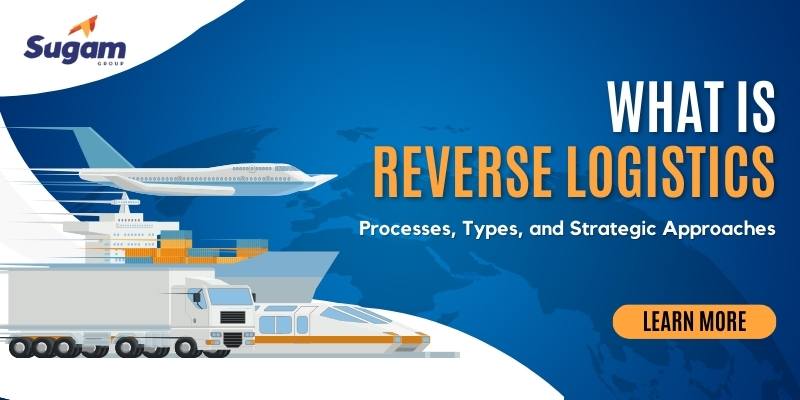What is Reverse Logistics: Processes, Types, and Strategic Approaches
In the dynamic world of logistics, businesses are constantly seeking innovative ways to streamline their operations, reduce costs, and minimise environmental impact. Reverse logistics, often an overlooked aspect of the supply chain, has gained significant attention in recent years. At Sugam Group, we understand the importance of staying at the forefront of industry trends and sustainability practices. In this blog, we will explore reverse logistics comprehensively, covering its types, processes, stages, and the pivotal role it plays in modern businesses.
What is Reverse Logistics?
Reverse logistics is the process of managing the return of products from the point of consumption back to the manufacturer or another destination for the purpose of returns, remanufacturing, recycling, reuse, or resale. While traditional logistics focuses on the movement of goods from manufacturers to consumers, reverse logistics is concerned with the opposite journey, from consumers back to the source. It’s a critical component for businesses looking to optimise their supply chain operations and reduce waste.
Types of Reverse Logistics
Reverse logistics encompasses various strategies, including returns, remanufacturing and refurbishing, recycling, reuse, and resale. These approaches play a pivotal role in efficiently managing product returns, reducing waste, and optimising sustainability in modern supply chains.
Returns: This is perhaps the most common type of reverse logistics, involving the return of products due to defects, damages, or customer dissatisfaction. Returned products are sorted and inspected to assess their condition. This step determines whether the items can be resold, refurbished, recycled, or need disposal. Effective warehousing solutions play a crucial role in this process. Learn more about warehousing in logistics to optimise your reverse logistics operations.
Remanufacturing and Refurbishing: Involves the restoration and enhancement of returned products to their original or better-than-original condition. This can significantly extend the product’s lifecycle.
Recycling: The recycling aspect of reverse logistics focuses on extracting raw materials or components from returned products to create new products or materials, thus reducing waste.
Reuse: Items that are returned but still in good condition can be cleaned, tested, and resold as refurbished or second-hand products.
Resale: In some cases, returned products can be resold as-is, especially when the return reason is unrelated to product quality.
What is the Reverse Logistics Process?
The reverse logistics process involves several key stages:
Collection
The first step is the collection of returned products. This can be done through various channels, such as return centres, drop-off locations, or even pick-up services. Efficient collection ensures that returned items are handled promptly.
Transportation
Returned products need to be transported from the collection point to a sorting and inspection facility. This may involve coordination with carriers, logistics providers, and carriers to optimise transportation routes and costs.
Sorting and Inspection
At this stage, returned products are inspected to determine their condition and disposition. Items are categorised into those suitable for resale, refurbishing, recycling, or disposal.
Reconditioning and Refurbishing
Products that can be salvaged and brought back to marketable condition undergo reconditioning or refurbishing processes. This may include repairs, cleaning, or upgrades to improve product quality.
Redistribution or Disposal
Finally, products are either reintroduced into the supply chain for resale, sent for recycling to extract valuable materials, or disposed of responsibly.
The Five Stages of Reverse Logistics
Reverse logistics comprises five essential stages: Returns Authorization, Collection and Transportation, Sorting and Inspection, Reconditioning and Refurbishing, and Redistribution or Disposal. These stages are integral to effectively managing product returns, minimising waste, and optimising supply chain sustainability.
Returns Authorization: The process begins with customers requesting returns due to various reasons. The returns authorization stage involves verifying the validity of the return and issuing return labels or instructions.
Collection and Transportation: After authorization, the returned items are collected from customers and transported to the designated facility for further processing.
Sorting and Inspection: Returned products are sorted and inspected to assess their condition. This step determines whether the items can be resold, refurbished, recycled, or need disposal.
Reconditioning and Refurbishing: Items in good condition but requiring minor repairs or refurbishment are reconditioned before being reintroduced into the supply chain.
Redistribution or Disposal: Finally, the products are either redistributed for resale or responsibly disposed of, depending on their condition and value.
How Does it Work?
Reverse logistics is not a one-size-fits-all process. It varies depending on the nature of the business, industry, and product type. Companies typically use specialised software and systems to track returned items, manage repairs, and make informed decisions about their final disposition. Explore our Multimodal Transportation solutions for efficient logistics.
Importance of Reverse Logistics to Your Business
Cost Savings: Effective reverse logistics can lead to cost savings by reducing waste and optimising product returns. Businesses can recover value from returned products through refurbishing, recycling, or resale.
Environmental Responsibility: Embracing reverse logistics contributes to sustainability efforts. Recycling and refurbishing reduce waste, and responsible disposal minimises environmental impact.
Customer Satisfaction and Loyalty: Efficient handling of returns and replacements enhances customer satisfaction and builds loyalty. A hassle-free return process can lead to repeat business. Learn more about our Express Cargo Service for speedy deliveries.
Compliance with Regulations: Compliance with environmental regulations and responsible disposal practices is critical for avoiding legal issues and reputational damage.
Competitive Advantage: Companies that excel in reverse logistics gain a competitive edge. They can offer refurbished or eco-friendly products, attracting environmentally conscious consumers.
Conclusion
Reverse logistics is not just a logistical process; it’s a strategy that can significantly impact your business’s bottom line and environmental footprint. At Sugam Group, we recognize the importance of embracing this vital aspect of supply chain management. By efficiently handling product returns, refurbishing items, recycling materials, and maintaining a commitment to sustainability, we ensure that our clients not only meet the demands of modern logistics but also contribute to a more environmentally responsible future. Reverse logistics is more than a trend; it’s a pathway to a greener and more efficient supply chain.




No Comments